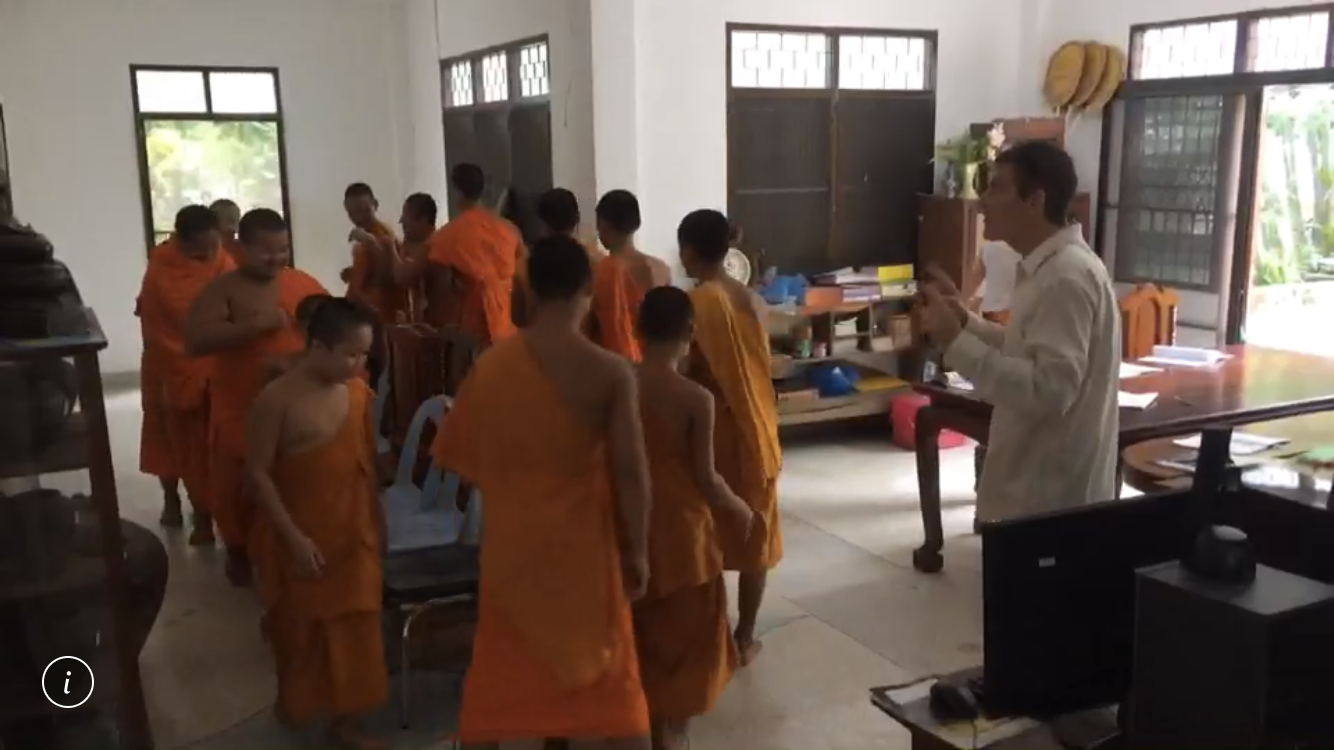As we near the tail end of two months spent volunteering as conversational English teachers in rural northern Thailand, it seems appropriate to record some of our reflections on the experience.
My wife and I come from a professional background in the American educational system. She was a middle school and high school math teacher for many years. She finished the last 10 years of her career as a high school administrator. I, on the other hand, was never a school teacher. Fortunately, I bring to the table the ability to converse easily on virtually any topic—a skill that was to prove useful in Thailand.
We were loosely assigned to teach at Doi Saket Phadungsasana School but found ourselves teaching mainly at Wat Wang Tan—a small temple a few miles away with some 16 novice monks living there.
A few words on the novices:
There are about 180 novices, representing perhaps 30 different temples, that attend the school. They come from a wide variety of backgrounds and parts of Thailand. Many, of course, come from Chiang Mai or Chiang Rai, while others may come from Surin Province (in the northeast of Thailand) or from one of the hill tribe villages near the Myanmar border.
The novices (which are about ages 10-17) vary in their command of the English language, with two variables perhaps playing significant roles:
Their cultural and family heritage. It seemed to me that a novice with at least one parent coming from an urban or more tourism-focused area might speak better English;
Their interest in learning the language. Some students, frankly, just don’t see any relevance in learning English. Their families have survived for generations without English—what makes now any different?
Indeed, one who is interested in learning to work on cars, sees value in learning the trade, and has a parent who works on cars, just might become pretty good at working on cars. Who knows, though.
At the school there’s an elementary level, which is largely separated from the rest of the students during the school day. The bulk of the students, though, are separated into six levels. Perhaps I should simply ask someone for the answer but it’s not yet clear to me why some of the level 1 students (which I assume to be entry-level students) are not only physically larger but sometimes speak better English than, say, a level 4 student. (For that matter, there’s a particular 10-year-old elementary student who may speak better English than 90% of the students in the school.) Overall, the level 6 students tend to have the strongest command of the English language.
My lack of understanding of this grade-level thing doesn’t matter much, for there’s a saying here that means little in the U.S. but makes practical sense here:
สบายๆ (sa-baai~sa-baai)
It basically means, “relaxed, chilled out, just rolling with it.”
My wife and I (who had good and honest intentions certainly) had a few good lessons to learn here. We were accustomed to professional predictability, strict scholastic regulation, and schedules that were meant to be followed—careers in government can imprint that on a person. But the “just roll with it” approach of teaching in a Thai monastic environment taught us that some (many!) things can be more important than a tight, compulsive structure aimed at achieving what usually amounts to some sort of arbitrary and fluctuating scholastic statistic; for instance, the desire to provide services to the community and the emphasis on monasticism over traditional formal education.
After all, this is a monastic school, not a public or private one. These young novices wear orange robes and have “gone forth” as 10-precept monks-in-training.
So what about the teaching?
Well, it is quite often exhausting but almost always very rewarding work. My wife and I have spent a lot of time brainstorming ideas and preparing lesson plans but one never knows how they’ll play out—again, the ages and English abilities vary considerably from student to student, and even within classes. Fortunately, my ability to conversationally riff allowed us to quickly open doors, connect with the students, and hopefully, pave the way to better conversing.
A slow work week here typically consists of one 90-minute class three days a week at Wat Wang Tan, while a busy work week might include the aforementioned plus maybe five 50-minute classes four days a week at the school. That’s a fair bit of teaching.
Despite a lot of time and effort, progress is slow. Our strongest students can hold a very basic introductory conversation. But it’s heartwarming to see little improvements here and there. It’s even more heartwarming to hear one say that he hopes to one day become an English teacher. And it’s yet more heartwarming when a student shares that he wants to keep in touch with you after you go back to your home country...because you have touched his heart, and because you teach him, and because he would someday like to come to America. Why? Well, we’ve asked that question to many of them.
Most common answer: They want to see snow.
This has been a beautiful experience. I would encourage anyone with good intentions and an open heart to consider donating their time in such a fashion.
Those are some of my reflections. If anyone has questions or would like to know more, just let me know.
(photo by our friend and co-volunteer Sue)

